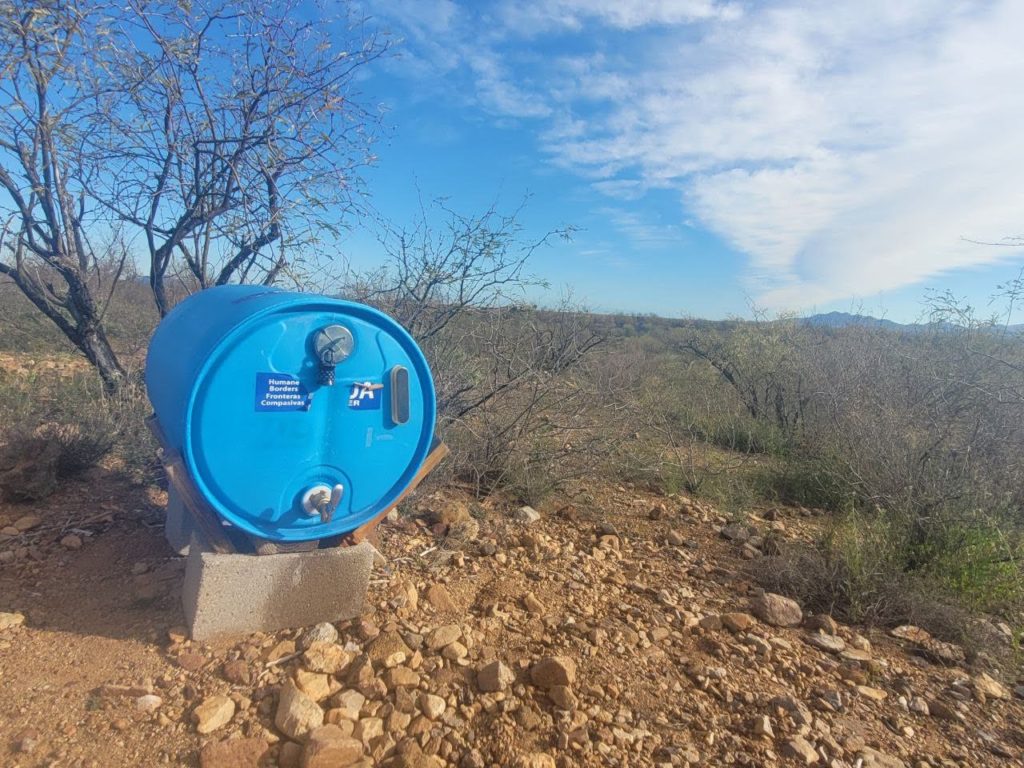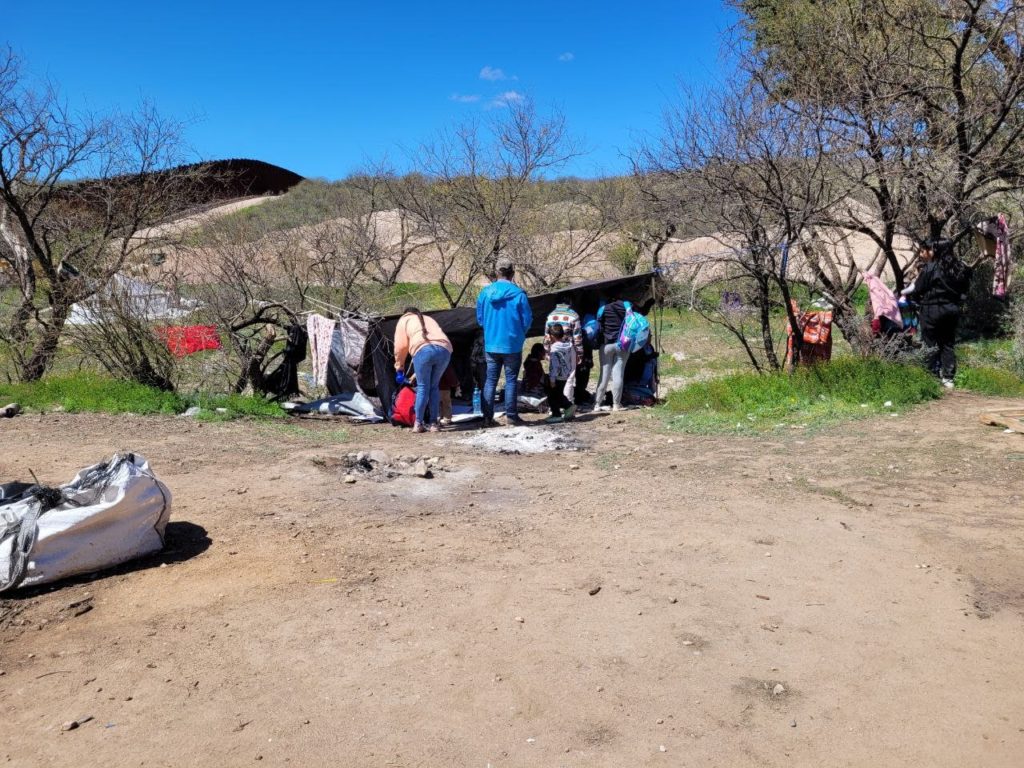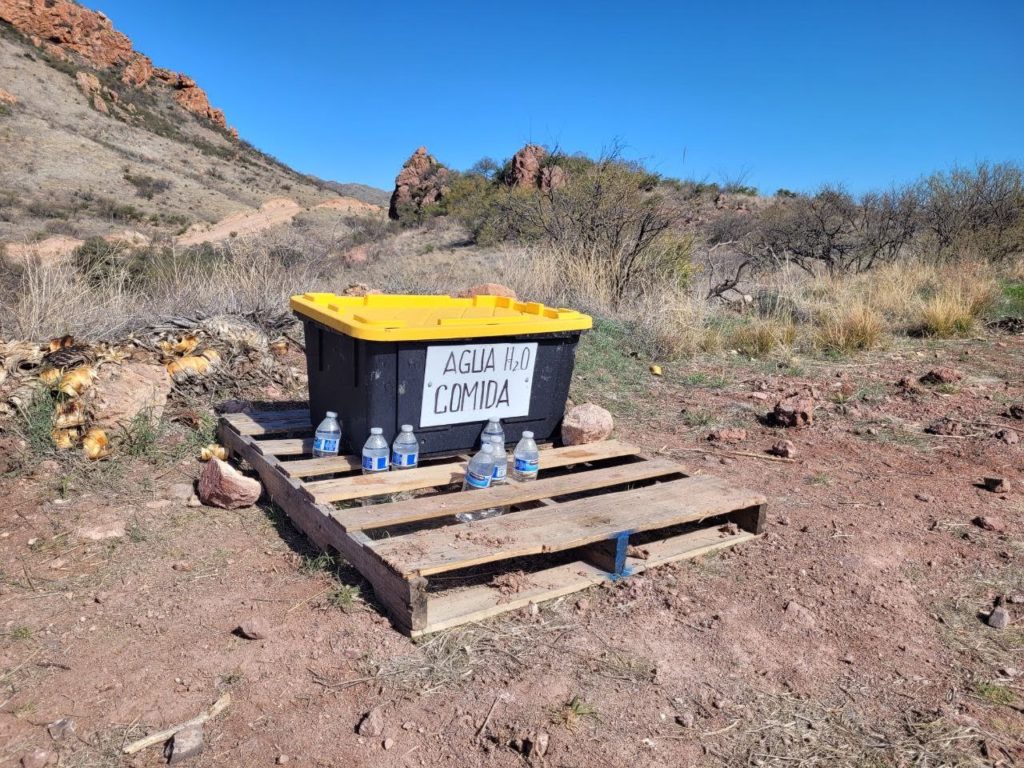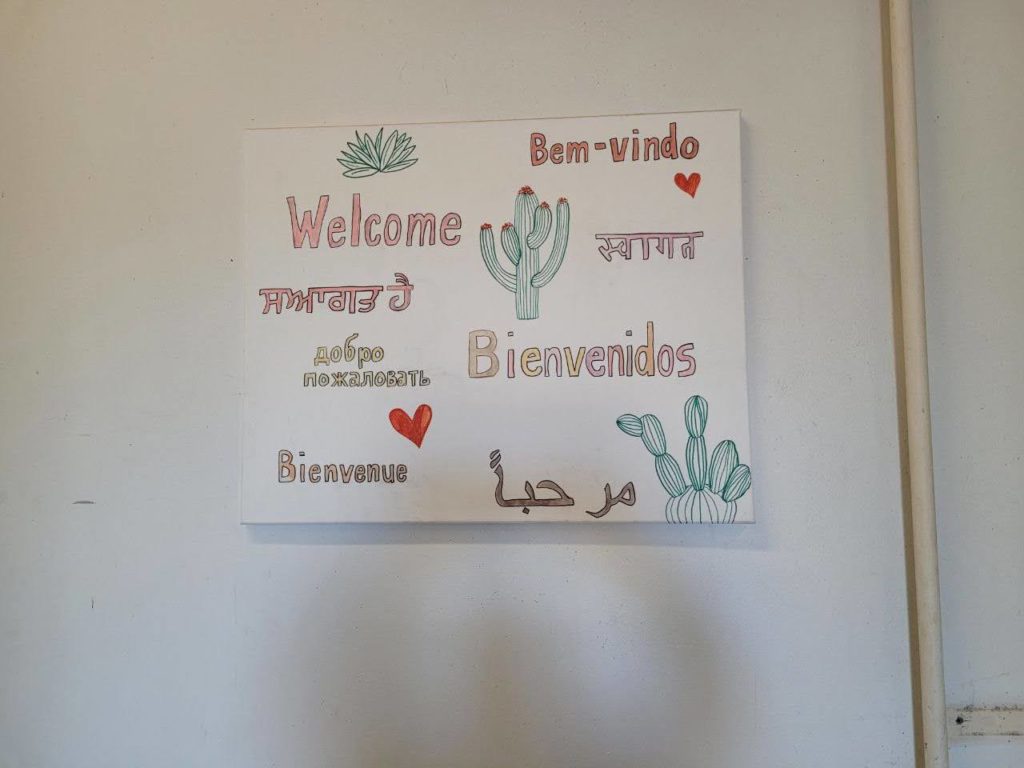Migrants traveling to the U.S. find a temporary refuge on the border with Mexico. Here, they rest and eat while waiting for U.S. Border Patrol agents to turn themselves in. They probably expect a hostile environment, which they are likely to find, but for now they feel welcome in the camp.
Text and photography: Allan Bu
“Tacos, tacos, would anyone like tacos?” Judy, one of the dozens of volunteers carrying out humanitarian work on the border, asks repeatedly. This is a desolate place in the state of Arizona near the border with Mexico. A migrant camp is located a few meters away from the border wall, which was built during the administration of Bill Clinton and fortified during the administration of Donald Trump. Judy is offering beef tacos to migrants, who are fleeing from poverty and violence in their countries.
She belongs to a faith-based group that leads the NGO No More Deaths – a humanitarian organization founded as a coalition of community and faith groups committed to stopping the death of migrants in the Sonoran Desert in Arizona. Since the camp was set up in December 2023, migrants find refuge after traveling hundreds, if not thousands, of kilometers to reach the U.S. and apply for asylum. Other organizations, such as the Tucson Samaritans and Humane Borders, have joined in the humanitarian work assisting migrants.
Having left their country behind, and in most cases their families, migrants don’t expect to receive tacos and a cup of coffee in U.S. territory. States have implemented stricter measures against undocumented migrants, and Donald Trump has repeatedly stated that migrants are terrorists and the U.S. is facing an invasion – a xenophobic discourse that resonates with his followers.
In Texas, Governor Gregg Abbott signed a bill that would make it a federal crime to illegally cross the border, allowing law enforcement officers to detain and deport undocumented migrants. However, this law was temporarily blocked by the U.S. Supreme Court. In Florida, seeking a reduction in illegal migration, Governor Ron DeSantis enacted FL SB-1718 in July 2023. This law allows authorities to prosecute individuals transporting undocumented migrants. Those charged could face up to 15 years in prison.
But in the migrant camp people forget about those laws. Selvin, a Honduran who recently arrived, is preparing tortillas with cheese. He’s the only fellow Honduran I find in the camp, and he’s happy to meet someone from his country. “I haven’t met anyone from Honduras on my journey. I came with people from other countries and sometimes used Google translate to communicate,” he says as he gives a tortilla with cheese to a young, weary Guatemalan. “This is tasty; it’s only missing chismol [tomato, onion and peppers],” he adds.

Selvin and other migrants take the opportunity to make calls, letting their relatives in the U.S. know they arrived safely. Most of them will be detained for at least three days by U.S. Border Patrol agents, and some will be deported. There is no phone coverage, but sometimes volunteers make arrangements to have Wi-Fi in the camp.
My conversation with Selvin is interrupted by Judy. “Are you Honduran?” she asks him. Yes, he says and tells her that tortillas with cheese are delicious. Judy tells us she was a volunteer for an NGO in El Progreso, in the Yoro department in northern Honduras. She has fond memories of her time there. She then leaves as she has to turn on the stove and prepare tacos, which she will give away to everyone at the camp in a few minutes.
She was preparing tacos when two women arrived on a noisy quad bike, causing a disturbance as they hadn’t been there before. One of them, a Guatemalan citizen, starts crying a few minutes after arriving. She is assisted by a volunteer.
After settling down, she tells us about her journey. She fled Guatemala because of violence. Being the owner of a small business, she was extorted by a criminal group and had to flee when she couldn’t pay them. She is overcome by emotions and bursts into tears. She had been aimlessly walking across the Sonoran Desert without food and water for five days.
She had abandoned all hope when she found a ranch near the border. There, the owner gave her food and water before bringing her to the camp. In tears, she tells us she almost died, a fate that has awaited thousands of migrants crossing the desert. She will turn herself in to U.S. Border Patrol agents.
Humanitarian groups strategically leave water tanks in the Sonoran Desert for migrants who hide from patrol agents and are not interested in seeking asylum. The desert is a solitary, inhospitable place where water is scarce and animals, including coyotes, dwell.

“An invasion”
Judy leads No More Deaths, but she’d rather not talk to media outlets; “I’m exhausted,” she says. However, she encourages us to talk to other volunteers, whom she invites to the conversation. This is where I met Nicholas Matthews, a 23-year-old volunteer who joined the Samaritans less than a month ago. He sometimes helps in the migrant camp. As a fluent Spanish speaker, he is also an interpreter.
He says the camp was set up in a location where around 200 people from Africa, Asia and Latin America had gathered. Migrants were enduring cold in a remote location, waiting to turn themselves in to U.S. Border Patrol agents. “Some families spent three nights in that place,” Matthews said. That’s when volunteers started setting up tents and bringing sheets. Now there’s coffee, water, bread, tortillas with cheese and tacos, of course.
Matthews is able to communicate with many Latin Americans arriving in the camp, but there are also people from Africa, the Middle East, and countries like Russia. Conversing with them, he learns about their stories. He says everyone should listen to migrants because despite the humanitarian work in this camp and other locations along the border, we cannot ignore that some groups in the U.S. see them as enemies.
The volunteers say there are people, who usually hold extreme nationalistic views, that wait for migrants, sometimes with their cameras, in their vehicles along the border. Matthews ran into one of those groups once, and they accused him of helping terrorists and drug traffickers. He thinks this is why people who live far from the border are frightened.
“Many extremists say it’s an invasion, but that’s a strong word that breeds hate toward migrants. I’m from Arizona and so were my ancestors; my family owns a house in Mexico. This is and has always been a border area. It [Arizona] was a part of Mexico 200 years ago and it’s now part of the U.S. Migrants have always crossed this territory, and the only difference is that they are seeking asylum now,” Matthews said.
Matthews knows that the discourse of “invasion and terrorism” has a lot to do with the November 2024 elections in which President Joe Biden will face former President Donald Trump, a politician at the helm of hate campaigns against migrants. “I think the media has created a crisis that does not really exist. I live in Tucson; I will go home in the evening and go out for dinner with my girlfriend. Life is normal here,” he said.
A couple of minutes later, Matthews leaves in his vehicle followed by two others. There is a migrant family in need of help a few kilometers away.
There is always work to do at the camp. Cristy Stewart, a retired teacher who has volunteered in Somalia and the Dominican Republic, has been with the Tucson Samaritans for seven years.
Groups of volunteers and migrants spread throughout the camp are conversing while Stewarts goes to the tents to fold the sheets used by migrants to warm themselves. Temperature fluctuates between 8 and 12 degrees Celsius in Arizona at this time of the year.
Stewarts says she was overjoyed to help an Ecuadorian family that stayed in one of the tents she recently set up. “I want this country to recognize that they are human beings. Look, he’s so happy eating an orange; he’s one of God’s children,” she said while pointing to a Guatemalan man.

Stewarts is saddened by the way some Americans and media outlets talk about people seeking a better life in the U.S. “I’ve read the crazy things people say about migrants in the newspaper: ‘that they are thieves, that they bring drugs or that they are going to kill us.’ It breaks my heart,” she says.
Humanitarian work
Volunteers make regular trips to the Sonoran Desert, leaving water and food for migrants who hide from U.S. Border Patrol agents and do not wish to turn themselves in. The food, which is non-perishable, can appease the hunger of a weary traveler. These supplies are provided by Humane Borders, the Tucson Samaritans and No More Deaths.
Data indicate that the Sonoran Desert is deadly for migrants, but the number of deaths is uncountable. The U.S.-Mexico border is the most dangerous land route for migrants worldwide, according to the International Organization for Migration (IOM).
Almost half of the 1,457 migrant deaths and disappearances documented in the Americas in 2022 took place in the U.S.-Mexico border, although OIM notes the actual numbers are higher due to the lack of official data provided by the governments of Mexico and the U.S.
The Sonoran Desert is one of the largest and warmest in the world. It has a surface area of more than 311,000 square kilometers and is located between the U.S. – Arizona and California – and Mexico – Baja California and Sonora. Many migrants have lost their lives in the desert while hiding from patrol agents.

Águilas del Desierto, an organization that rescues disappeared migrants in this vast territory, receives around 450 reports of missing persons in need of rescue every month. Volunteers try to reduce the deaths of migrants, sometimes going many kilometers deep into the desert. Humanitarian organizations set up the camp because there were many people waiting to turn themselves in to authorities, who would take up to three days to arrive, and it can get cold, especially in December.
Those who stay in the camp want to apply for asylum. They don’t want to run among the bushes in the desert or hide until someone finds them.
Once they’re in custody of U.S. authorities, they are taken to a detention center, where they have to fill out paperwork and answer specific questions about why they are in that country. Migrants’ possibility of continuing the asylum process depends on the reasons for migrating to the U.S.
Sebastián Quinac, a Guatemalan who arrived as an undocumented migrant in the U.S. almost 40 years ago, has been helping migrants in the same situation for decades. When authorities encounter migrants, they only ask them a few questions, he says. Migrants have told him that one of the most important questions is if they fear returning to their country.
Once asylum seekers arrive at their destination, they’re expected to notify migration authorities. A credible fear screening takes place about two months later, but this is the step migrants are hesitant about because they know many are deported afterwards, Quinac says.
In the credible fear screening, migrants should establish a “significant possibility” that they “have been persecuted or have a well-founded fear of persecution” if they return to their country. However, this is only one step of the application for asylum.
The U.S. government stipulates that a person may apply for asylum if they have been persecuted or fear that they will be persecuted due to race, religion, nationality, membership in a social group or political opinions.
On the other hand, there are reasons for which people may not be granted asylum like persecuting others on account of race, religion, nationality, membership in a particular social group or political opinions. Similarly, a person would be denied asylum if they have committed a serious crime, a nonpolitical serious crime outside the U.S. or if they are a danger to the security of the country.
According to U.S. law, migrants should receive a response from authorities within six months of applying for asylum, but the system is overwhelmed with a backlog of more than two million applications pending in immigration courts.

Casa Alitas, a program within the Catholic Community Services of Southern Arizona, has two shelters where they assist migrants who have gone through the screening process and are allowed to enter the country. Quinac has a small office in one of the shelters where he provides guidance to migrants on seeking asylum and finding their relatives and friends in the U.S. And Casa Alitas’s office at Tucson International Airport offers assistance to migrants flying to their destinations, where an uncertain future awaits them.
For the Tucson Samaritans, Casa Alitas’s work is the end of a cycle of humanitarian work that begins with offering coffee and tacos to migrants a few meters away from the border wall. They give hope to people like Selvin, the only Honduran migrant I found in the camp, who tells me while eating a tortilla with cheese: “I have faith that I’ll make it.”






